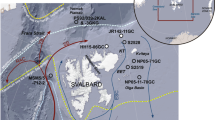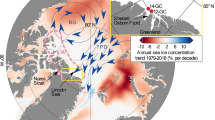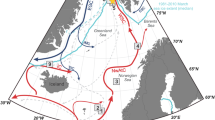Abstract
Sea ice is a critical component of the climate system: variations in sea-ice cover affect the albedo of polar regions, and also the rate of deepwater formation1,2. Changes in the sea-ice cover of the North Atlantic Ocean are thought to have been related to abrupt climate changes throughout the last glacial termination3, but reconstructions of sea-ice conditions are rare. Here we use the sedimentary abundance of the IP25 and brassicasterol biomarkers, produced by sea-ice-associated diatoms and open-water phytoplankton, respectively, to generate a record of sea-ice conditions in the northernmost Atlantic Ocean for the past 30,000 years. Our reconstruction shows that a stationary margin between sea-ice cover and the open ocean existed during the Last Glacial, although perennial sea-ice cover prevailed for most of the Last Glacial Maximum. An early warming about 14,000 years ago was associated with ice-free conditions; however, seasonal sea ice was present throughout the Holocene. We find temporal links between our record of sea ice and reconstructions of the amount of relatively warm Atlantic water advected into the Nordic Seas4,5. We therefore conclude that changes in sea-ice conditions are linked to regional and global climate anomalies and oceanographic circulation in the North Atlantic.
This is a preview of subscription content, access via your institution
Access options
Subscribe to this journal
Receive 12 print issues and online access
$259.00 per year
only $21.58 per issue
Buy this article
- Purchase on Springer Link
- Instant access to full article PDF
Prices may be subject to local taxes which are calculated during checkout



Similar content being viewed by others
References
Rudels, B. in The Arctic and Environmental Change (eds Wadhams, P., Dowdeswell, J. A. & Schofield, A. N.) 87–99 (Gordon and Breach, 1996).
Dieckmann, G. S. & Hellmer, H. H. in Sea Ice (eds Thomas, D. N. & Dieckmann, G. S.) 1–21 (Blackwell, 2003).
Severinghaus, J. P. & Brook, E. J. Abrupt climate change at the end of the last glacial period inferred from trapped air in polar ice. Science 286, 930–934 (1999).
Koç, N., Jansen, E. & Haflidason, H. Paleoceanographic reconstructions of surface ocean conditions in the Greenland, Iceland and Norwegian seas through the last 14 kyr based on diatoms. Quat. Sci. Rev. 12, 115–140 (1993).
Andersen, C., Koç, N., Jennings, A. & Andrews, J. T. Nonuniform response of the major surface currents in the Nordic Seas to insolation forcing: Implications for the Holocene climate variability. Paleoceanography 19, PA2003 (2004).
Belt, S. T. et al. A novel chemical fossil of palaeo sea ice: IP25 . Org. Geochem. 38, 16–27 (2007).
Massé, G. et al. Abrupt climate changes for Iceland during the last millennium: Evidence from high resolution sea ice reconstructions. Earth Planet. Sci. Lett. 269, 565–569 (2008).
Volkman, J. K. et al. Microalgal biomarkers: A review of recent research developments. Org. Geochem. 29, 1163–1179 (1998).
Birgel, D. & Hass, H. C. Oceanic and atmospheric variations during the last deglaciation in the Fram Strait (Arctic Ocean): A coupled high-resolution organic-geochemical and sedimentological study. Quat. Sci. Rev. 23, 29–47 (2004).
Stein, R. & Fahl, K. Scientific cruise report of the arctic expedition ARK-XIII/2 of RV Polarstern in 1997. Ber. Polarforsch. 255, 98–136 (1997).
Nørgaard-Pedersen, N. et al. Arctic Ocean during the Last Glacial Maximum: Atlantic and polar domains of surface water mass distribution and ice cover. Paleoceanography 18, 1063–1082 (2003).
Andersen, E. S., Dokken, T. M., Elverhøi, A., Solheim, A. & Fossen, I. Late quaternary sedimentation and glacial history of the western Svalbard continental margin. Mar. Geol. 133, 123–156 (1996).
Mangerud, J. et al. Fluctuations of the Svalbard–Barents sea ice sheet during the last 150,000 years. Quat. Sci. Rev. 17, 11–42 (1998).
Sarnthein, M., Pflaumann, U. & Weinelt, M. Past extent of sea ice in the northern North Atlantic inferred from foraminiferal paleotemperature estimates. Paleoceanography 18, 1047–1058 (2003).
Birgel, D. & Stein, R. in The Organic Carbon Cycle in the Arctic Ocean (eds Stein, R. & MacDonald, G. M.) (Springer, 2004).
Knies, J. & Stein, R. New aspects of organic carbon deposition and its paleoceanographic implications along the northern Barents Sea margin during the last 30,000 years. Paleoceanography 13, 384–394 (1998).
Smith, W. O. Jr, Baumann, M. E. M., Wilson, D. L. & Aletsee, L. Phytoplankton biomass and productivity in the marginal ice zone of the Fram Strait during summer 1984. J. Geophys. Res. 92, 6777–6786 (1987).
Birgel, D., Stein, R. & Hefter, J. Aliphatic lipids in recent sediments of the Fram Strait/Yermak Plateau (Arctic Ocean): composition, sources and transport processes. Mar. Chem. 88, 127–160 (2004).
Knies, J., Vogt, C. & Stein, R. Late Quaternary growth and decay of the Svalbard/Barents Sea ice sheet and paleoceanographic evolution in the adjacent Arctic Ocean. Geo-Mar. Lett. 18, 195–202 (1999).
Stein, R. Arctic Ocean Sediments: Processes, Proxies, and Paleoenvironment (Elsevier, 2008).
Knies, J., Kleiber, H.-P., Matthiessen, J., Müller, C. & Nowaczyk, N. Marine ice-rafted debris records constrain maximum extent of Saalian and Weichselian ice-sheets along the northern Eurasian margin. Glob. Planet. Change 31, 45–64 (2001).
Grootes, P. M., Stuiver, M., White, J. W. C., Johnsen, S. & Jouzel, J. Comparison of oxygen isotope records from the GISP2 and GRIP Greenland ice cores. Nature 366, 552–554 (1993).
Wollenburg, J. E., Knies, J. & Mackensen, A. High-resolution paleoproductivity fluctuations during the past 24 kyr as indicated by benthic foraminifera in the marginal Arctic Ocean. Palaeogeogr. Palaeoclimatol. Palaeoecol. 204, 209–238 (2004).
Bondevik, S., Mangerud, J., Birks, H. H., Gulliksen, S. & Reimer, P. Changes in north Atlantic radiocarbon reservoir ages during the Allerød and Younger Dryas. Science 312, 1514–1517 (2006).
Bradley, R. S. & England, J. H. The Younger Dryas and the sea of ancient ice. Quat. Res. 70, 1–10 (2008).
Slubowska-Woldengen, M. et al. Time-slice reconstructions of ocean circulation changes on the continental shelf in the Nordic and Barents Seas during the last 16,000 cal yr BP. Quat. Sci. Rev. 27, 1476–1492 (2008).
Hald, M. et al. Variations in temperature and extent of Atlantic Water in the northern North Atlantic during the Holocene. Quat. Sci. Rev. 26, 3423–3440 (2007).
Kleiven, H. F. et al. Reduced north Atlantic deep water coeval with the Glacial Lake Agassiz freshwater outburst. Science 319, 60–64 (2008).
Hebbeln, D., Dokken, T., Andersen, E. S., Hald, M. & Elverhøi, A. Moisture supply for northern ice-sheet growth during the Last Glacial Maximum. Nature 370, 357–360 (1994).
Steinsund, P. I. & Hald, M. Recent calcium carbonate dissolution in the Barents Sea: Paleoceanographic applications. Mar. Geol. 117, 303–316 (1994).
Acknowledgements
We thank S. J. Rowland and D. Birgel for discussions on the use of selected biomarkers and for provision of some geochemical data from PS2837-5. Financial support was provided by the Deutsche Forschungsgemeinschaft, STE 412/24-1, the European Research Council (StG project 203441) and the UK Natural Environmental Research Council (NE/D013216/1).
Author information
Authors and Affiliations
Contributions
All authors contributed equally to this work; S.T.B. and G.M. designed the analytical method; J.M. carried out experiments, analysed data and drafted the original manuscript; all authors interpreted the results and contributed to the final manuscript.
Corresponding author
Rights and permissions
About this article
Cite this article
Müller, J., Massé, G., Stein, R. et al. Variability of sea-ice conditions in the Fram Strait over the past 30,000 years. Nature Geosci 2, 772–776 (2009). https://doi.org/10.1038/ngeo665
Received:
Accepted:
Published:
Issue Date:
DOI: https://doi.org/10.1038/ngeo665
This article is cited by
-
Sea ice-ocean coupling during Heinrich Stadials in the Atlantic–Arctic gateway
Scientific Reports (2024)
-
Coastal permafrost was massively eroded during the Bølling-Allerød warm period
Communications Earth & Environment (2023)
-
Exploring late Pleistocene bioturbation on Yermak Plateau to assess sea-ice conditions and primary productivity through the Ethological Ichno Quotient
Scientific Reports (2023)
-
Seasonal sea-ice in the Arctic’s last ice area during the Early Holocene
Communications Earth & Environment (2023)
-
Climate changes modulated the history of Arctic iodine during the Last Glacial Cycle
Nature Communications (2022)



